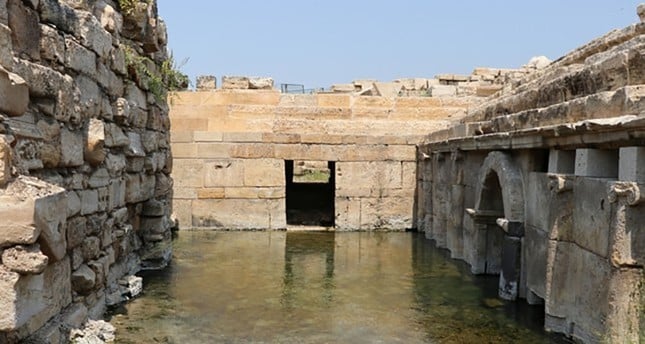
The famed “Gate to Hell” at the ruins of the ancient Greek city of Hierapolis in western Turkey opened to regular visitors in 2022.
Known also as Pluto’s Gate—Ploutonion in Greek, Plutonium in Latin—the cave was celebrated as the portal to the underworld in Greco-Roman mythology and tradition.
Its name is derived from a combination of mythology and the practical application of scientific facts. It was said that it was Hades’ lethal breath that killed those who came near. Those who approached died and were immediately taken to the underworld.
The site is built on top of a cave that emits toxic gases, hence its use as a ritual passage to the underworld. Ritual animal sacrifices were common at the site. Animals would be thrown into the cave and pulled back out with ropes that had been tied to them.
Archaeologists noted that the fumes emitted from the cavern still maintain their deadly properties as they recorded passing birds, attracted by the warm air, suffocated after breathing the toxic fumes.
A 2013 study led by Italian professor Francesco D’Andria discovered that the high carbon dioxide levels emitted from the ground where the gate is located were the source of the animals’ deaths.
After the 2013 expedition, the area was closed for security reasons over the poisonous emissions which went unnoticed for centuries since the phenomenon was confined to the “gate” and largely forgotten.
Further excavation work followed before the crumbling stones of the gate were restored and statues were erected on top of the terrace-like structure next to the gate. A walkway placed a safe distance from the gate allows visitors to peek through the ancient underworld for sinners.
“Gate to Hell” has a scientific explanation
Scientists say the explanation is much simpler. According, to a Daily Sabah report, a team of German researchers from the University of Duisburg-Essen found what was actually “Hades’ breath.”
They discovered that the grotto sits directly above the Babadag fault line from which carbon dioxide escapes the Earth’s crust and fills the cave at levels that may have been lethal to humans in ancient times.
”In a grotto below the temple of Pluto, CO2 was found to be at deadly concentrations of up to 91 percent,” reported a study published in the journal Archaeological and Anthropological Sciences.
“Astonishingly, these vapors are still emitted in concentrations that nowadays kill insects, birds and mammals,” the report added.
Hierapolis was an ancient Greek city located on hot springs
Hierapolis was an ancient Greek city located on hot springs in classical Phrygia in southwestern Anatolia. Its ruins are adjacent to modern Pamukkale in Turkey and currently comprise an archaeological museum. The site has the Tomb of Philip the Apostle.
The hot springs have been used as a spa since the 2nd century BC, with many patrons retiring or dying there. The large necropolis is filled with sarcophagi, most famously that of Marcus Aurelius Ammianos, which bears a relief depicting the earliest known example of a crank and rod mechanism.
The great baths were constructed with huge stone blocks without the use of cement and consisted of various closed or open sections linked together. There are deep niches in the inner section, including the bath, library, and gymnasium.
It was added as a UNESCO World Heritage Site in 1988.